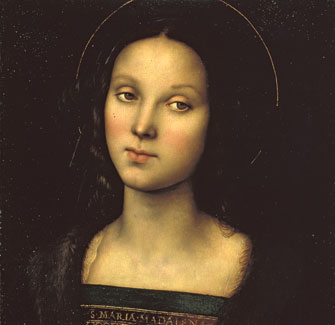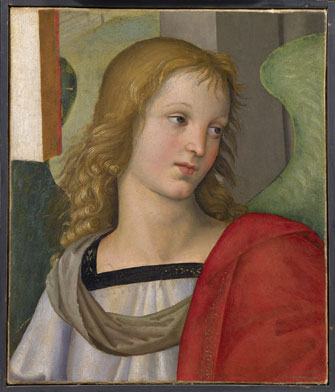Rehabilitating a
Renaissance Painter

Detail of Perugino’s “Mary Magdalen” (c. 1500-02). © Soprintendenza Speciale per il Patrimonio Storico Artistico ed Etnoantropologico e per il Polo Museale della Città da Firenze
The work of the painter Pietro Perugino (c. 1450-1523), born Pietro Vannucci, is something of a compendium of developments in the art of painting of the Renaissance. The current exhibition at the Musée Jacquemart-André, “Perugino, Raphael’s Master,” shows how he was influenced by the other great artists of the day and passed on that legacy to those who came after him.
During his lifetime, Perugino was considered one of the great Renaissance masters and the equal of his contemporary Leonardo da Vinci. By the end of their lives, however, Leonardo had eclipsed Perugino, and one of his followers, Raphael (who may or may not have been his apprentice but certainly knew his work well), had taken what he had learned from Perugino to new heights and in new directions.
The fact remains that Perugino was an influential innovator in his time, as the exhibition, the first in France devoted to the artist, sets out to show with some 50 paintings.
Although Perugino worked in Perugia, not one of the major centers of Renaissance art like Venice, Florence or Rome, he visited them all. As a young man, he studied under Andrea del Verrocchio in Florence, where he met Leonardo and Botticelli, fellow pupils of Verrocchio, and saw the work of such masters as Donatello and Masaccio.
Always interested in learning new techniques, he borrowed from Giorgione a revolutionary way of treating shadows in color, which had itself originated with Leonardo, whose sfumato technique (the blending of tones into one another) Perugino also adopted. He paid attention, too, when the works of the Flemish painters, with their great attention to fine detail, began to appear in Italy.
He brought all these modern techniques back to Perugia and put them to good use in mostly religious works, although he did do some paintings of profane subjects, a few of which are included in the exhibition. His reputation reached beyond the Umbrian city, however, and he was put in charge of the wall decoration of the Sistine Chapel, in which capacity he directed such important painters as Ghirlandaio, Botticelli and Rosselli.
The exhibition offers visitors the opportunity to follow Perugino’s evolution as he absorbed all these influences, and compares his work with that of other great Renaissance artists, including Verrocchio, Botticelli, Pinturicchio and, of course, Raphael.
The last two rooms take us through the transition from the style of Perugino to Raphael, with some works that could be attributed to either (e.g., the predella of the Fano Alterpiece) and others that are clearly by Perugino (the San Pietro Polyptych) or Raphael (the predella of the Oddi Altarpiece).
In the final room, Raphael takes over with several works that show how he, in turn, absorbed the lessons learned from Perugino and then moved on. In a partial re-creation of the St. Nicolas of Tolentino Altarpiece, elements of which have been brought together from three different museums, the sweet angel on the right (pictured below) shows the influence of Perugino, while the more dynamic

Raphael’s angel from the St. Nicolas of Tolentino Altarpiece (1501). © Pinacoteca Tosio Martinengo, Brescia
one on the left is pure Raphael.
The Jacquemart-André has once again given an exhibition a rather misleading name – it has never been proven that Perugino was Raphael’s master, and the title uses the better-known artist’s name and paintings as a kind of lure to visitors. This was completely unnecessary, however, since the exhibition itself demonstrates that Perugino’s work can stand alone.
Musée Jacquemart-Andre: 158, boulevard Haussmann, 75008 Paris. Métro: Miromesnil. Tel.: 01 45 62 11 59. Open daily, 10am-6pm, until 8:30pm on Monday and Saturday. Admission: €12. Through January 19, 2015. www.musee-jacquemart-andre.com
Click here to read all of this week’s new articles on the Paris Update home page.
Reader Reaction: Click here to respond to this article (your response may be published on this page and is subject to editing).
Support Paris Update by ordering books from Paris Update’s Amazon store at no extra cost. Click on your preferred Amazon location: U.K., France, U.S.
© 2014 Paris Update
Favorite